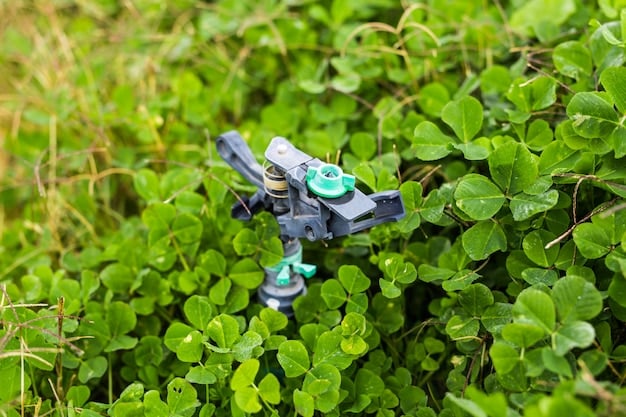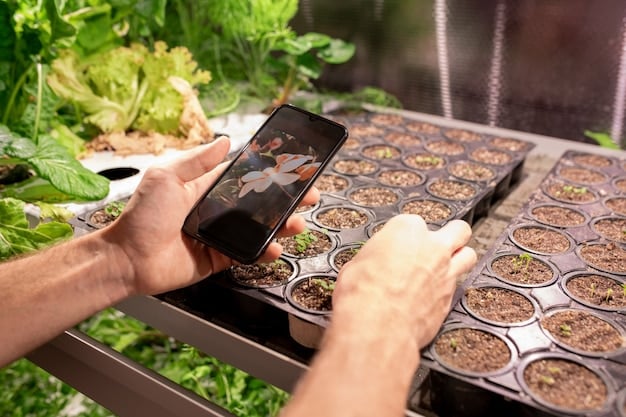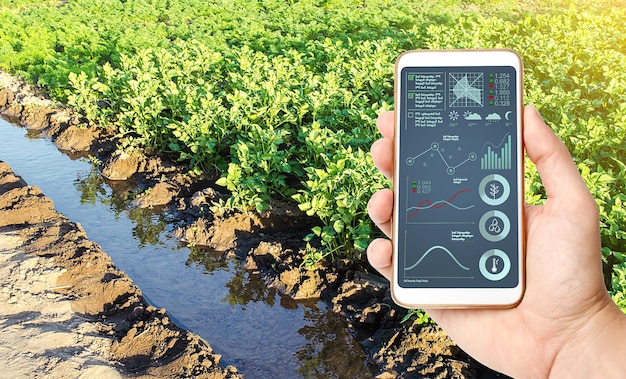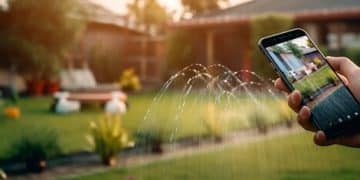Smart Irrigation: Can Tech Reduce Water Use by 25% in Gardens?

Smart garden technology, particularly through smart irrigation systems, holds the potential to significantly reduce water consumption in gardens, with some studies suggesting potential savings of up to 25% by optimizing watering schedules and delivery.
Can technology really help us both save water and keep our gardens thriving? The answer lies in smart garden technology. Specifically, the big question is: can smart irrigation systems actually reduce water consumption by 25%? Let’s dive into the facts and explore the benefits.
Understanding Smart Garden Technology
Smart garden technology is revolutionizing how we care for our outdoor spaces. It’s about using sensors, data analysis, and automated systems to make gardening more efficient and less wasteful.
At the heart of this technology are smart irrigation systems. These systems go beyond simple timers, offering more intelligent ways to water your garden.
What are Smart Irrigation Systems?
Smart irrigation systems use data from weather forecasts, soil moisture sensors, and plant-specific needs to determine when and how much to water. This eliminates guesswork and ensures plants receive the precise amount of water they need.
These systems can be controlled remotely via smartphone apps, allowing you to adjust watering schedules even when you’re away. This level of control and customization is a game-changer for water conservation.
- Weather-Based Irrigation: Adjusts watering schedules based on real-time weather data.
- Soil Moisture Sensors: Measures the moisture level in the soil and waters only when necessary.
- Remote Control: Allows users to monitor and adjust watering schedules from anywhere.
Essentially, smart irrigation systems are about right water, right place, right time. This precise approach maximizes water efficiency and promotes healthier plant growth.
Can Smart Irrigation Really Cut Water Use by 25%?
The promise of significant water savings is a major draw for smart irrigation systems. But is a 25% reduction realistic? Let’s look at some evidence.
Numerous studies and real-world applications suggest that smart irrigation can indeed lead to substantial water conservation. However, the actual percentage varies depending on factors like climate, plant types, and system setup.
Studies and Real-World Results
Research has shown that, compared to traditional irrigation methods, smart systems can reduce water use by anywhere from 20% to over 50%. The 25% mark is a reasonable and achievable target for many homeowners.
One study conducted by the Irrigation Association found that weather-based irrigation controllers saved an average of 27% more water than traditional timers. This demonstrates the potential for significant savings with smart technology.

It’s important to remember that these savings are not guaranteed. They require proper installation, calibration, and ongoing monitoring of the system. However, the potential is definitely there.
Key Features of Water-Efficient Smart Irrigation
Not all smart irrigation systems are created equal. Certain features contribute more to water efficiency than others. Knowing what to look for can help you choose the right system for your needs.
Look for systems that incorporate multiple water-saving technologies, such as weather-based adjustments and soil moisture sensors. The combination of these features maximizes efficiency and ensures optimal watering.
Essential Features for Water Savings
Here are some must-have features for a water-efficient smart irrigation system:
- Weather-Based Adjustments: Automatically adjusts watering schedules based on local weather forecasts.
- Soil Moisture Sensors: Monitors soil moisture levels and prevents overwatering.
- Zoned Watering: Allows you to customize watering schedules for different areas of your garden based on plant type and sun exposure.
- Leak Detection: Alerts you to leaks or malfunctions in the system, preventing water waste.
By choosing a system with these features, you can maximize your water savings and ensure your garden stays healthy and vibrant.
Furthermore, ease of use and app control are critical for water efficiency. A smart system that is hard to understand may not be used correctly, reducing potential savings.
How to Choose the Right Smart Irrigation System
Selecting the right smart irrigation system can feel overwhelming. With so many options available, it’s crucial to consider your specific needs and garden conditions.
Start by assessing the size of your garden, the types of plants you have, and your local climate. This will help you determine the type of system that will work best for you.
Factors to Consider When Choosing a System
Before making a purchase, consider these factors:
- Garden Size: Choose a system that is appropriately sized for your garden.
- Plant Types: Select a system that allows you to customize watering schedules for different plant types.
- Climate: Consider your local climate and choose a system that can adjust to changing weather conditions.
- Budget: Smart irrigation systems range in price. Set a budget and find a system that meets your needs within that budget.
Consider reading reviews and comparing different models. Look for systems that are highly rated for water efficiency, ease of use, and reliability.
Don’t forget to factor in professional installation. While some systems are DIY-friendly, others may require professional installation, which can add to the overall cost.

Installation and Maintenance Tips
Proper installation and maintenance are essential for maximizing the water-saving potential of your smart irrigation system. Neglecting these aspects can lead to reduced efficiency and potential problems.
Follow the manufacturer’s instructions carefully during installation. Ensure that all components are properly connected and that the system is calibrated correctly.
Maintaining Your Smart Irrigation System
Here are some tips for maintaining your system:
- Regular Inspections: Check your system regularly for leaks, clogs, or malfunctions.
- Sensor Calibration: Calibrate soil moisture sensors periodically to ensure accurate readings.
- Winterization: Protect your system from freezing temperatures during the winter months.
- Software Updates: Keep your system’s software updated to ensure optimal performance.
Consider setting up a maintenance schedule to ensure that your system remains in good condition. This will help you avoid costly repairs and ensure that you continue to save water.
Proactive maintenance will help ensure great water savings for years to come. Remember to always consult the manufacturer’s guides for specific instructions.
The Future of Smart Garden Tech
Smart garden technology is constantly evolving, with new innovations emerging all the time. As technology advances, we can expect even greater water efficiency and convenience.
The future of smart garden tech includes more integration with other smart home devices, advanced sensors, and AI-powered decision-making.
Emerging Trends in Smart Gardening
Here are some exciting trends to watch for:
- AI-Powered Irrigation: Systems that use artificial intelligence to optimize watering schedules based on complex data analysis.
- Drone-Based Monitoring: Drones equipped with sensors that can assess plant health and detect areas that need more attention.
- Customized Plant Care: Systems that provide personalized care recommendations based on the specific needs of each plant.
These advances will further enhance our ability to conserve water and create thriving, sustainable gardens. The possibilities are very exciting.
Smart garden tech is a great opportunity for those looking to save water and provide the best care for their plants. Water conservation is extremely important and can make a tangible difference for the environment.
| Key Point | Brief Description |
|---|---|
| 💧 Smart Irrigation | Uses sensors and data to optimize watering schedules. |
| 📊 25% Water Reduction | Smart systems can realistically reduce water use by 25%. |
| 🌱 Key Features | Weather-based adjustments, soil moisture sensors, zoned watering. |
| 🛠️ Maintenance | Regular inspections, sensor calibration, winterization are important. |
FAQ
▼
Smart irrigation systems use sensors, weather data, and programmed schedules to automatically water plants. They adjust watering based on real-time conditions, optimizing water usage.
▼
Yes, by reducing water waste, these systems can lower your water bill. The initial investment is often offset by long-term savings and healthier plant growth.
▼
Some systems are designed for DIY installation, while others require professional help. Consider your comfort level with home improvement projects when choosing a system.
▼
Many smart irrigation systems offer zoned watering, allowing you to customize watering schedules for different areas of your garden with varying plant needs.
▼
Regularly inspect for leaks, clogs, and sensor malfunctions. Calibrate sensors as needed and protect the system from freezing temperatures during the winter.
Conclusion
Smart irrigation systems offer a powerful way to reduce water consumption and maintain a healthy garden. By adopting this technology, you can contribute to water conservation efforts, save money, and enjoy a thriving outdoor space.





